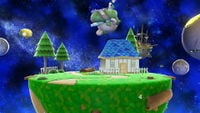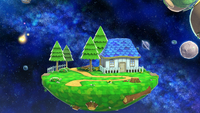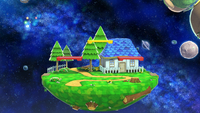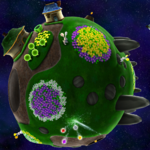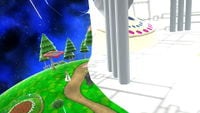Mario Galaxy
| Super Mario Galaxy Mario Galaxy | |
|---|---|
{{{content1}}}
{{{content2}}}  Mario Galaxy as it appears in Smash. | |
| Universe | Mario |
| Appears in | SSB4 (Wii U) Ultimate |
| Availability | Starter |
| Crate type | Normal |
| Maximum players | 8 |
| Article on Super Mario Wiki | Mario Galaxy (stage) |
| “ | Mario Galaxy is a bit of an odd stage. The planetary gravity is tightly bound to the core, so jumps straight off platforms or directly upward will tend to send fighters in a diagonal direction. | ” |
| —Super Smash Bros. 4 Official Site | ||
Mario Galaxy (マリオギャラクシー, Mario Galaxy) is a stage that appears in Super Smash Bros. for Wii U and Super Smash Bros. Ultimate. It was officially confirmed on November 15, 2013, though one of the daily pics on the site teased it as much as two months prior. This stage is available as one of the stages in 8-Player Smash. In Ultimate, Rosalina & Luma are fought here for their unlock battle.
Stage overview
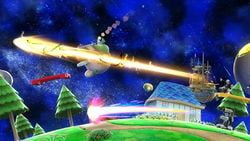
The characters fight on a small, grassy planet in deep space. The background features a few trees and a house on the ground and, except in 8-Player mode, several spaceships in the sky.
Due to the planet's small size, the stage has a noticeable curvature to it: the center of gravity is the center of the planet, so jumping or getting launched upwards from the edge will cause the character to move diagonally. Most projectiles are also affected by gravity and move according to the planet's curvature, with a few exceptions, notably Fox's Blaster and Robin's Thoron.
Two static soft platforms are present, one on the right and one, higher, at the left. The stage also features walk-off blast lines. Star bits may occasionally rain down on the stage, though this has no effect on the fight.
Despite the game's attempt to emulate curved gravity, the ground on the sides of the stage still behaves like a downwards slope of increasing intensity, and as such fighters who land on the ground will slide backwards a distance depending on their fall speed and traction, and fighters who are meteor smashed into it will bounce off at a wider angle.
Ω forms and Battlefield form
In Super Smash Bros. for Wii U, the Ω form is set on a completely flat and smaller version of the planet the regular form is set on with walk-offs removed and gravity normalized.
In Super Smash Bros. Ultimate, the Ω form and Battlefield form are similar to SSB4's Ω form; however, the main platform is resized and reshaped to match Final Destination and Battlefield, respectively. The three soft platforms of the Battlefield form are based on the two multicolored soft platforms in the normal form.
Origin
This stage is based on both Super Mario Galaxy games. In the games, Mario would navigate through galaxies by going from planet to planet, with each planet having its own gravitational pull, to reach the Power and Grand Stars. The planet on which characters fight in this stage is based on the starting planet of Gateway Galaxy, the first galaxy in Super Mario Galaxy, albeit with some differences such as the addition of the pine trees in the background, the presence of only one house instead of two (the house is also designed differently), and the much larger size of the planet itself.
Worthy of note is that at the end of Super Mario Galaxy, the universe is reborn so that elements from many galaxies visited during the game end up closer to one another, so the stage may have also gotten some influence from that, given that in Super Mario Galaxy there is no place called "Mario Galaxy".
The ships in the background are:
- Bowser's Airships, whose design is based on their appearance in Super Mario Galaxy.
- Starship Mario along its pilot Lubba and some Lumas. They debuted in Super Mario Galaxy 2, where Lubba would pilot Starship Mario to the different galaxies in the game.
- The Starshroom, the starship of the Toad Brigade which appears in both Super Mario Galaxy games.
Tournament legality
Mario Galaxy is banned from tournaments due to the stage having walk-off blast zones and unusual gravity which interferes with projectiles and movement.
Gallery
Super Smash Bros. for Wii U
Mario and two Ray Guns in the stage.
Super Smash Bros. Ultimate
Corrin using his neutral attack on the stage.
Dr. Mario taunting on the stage.
Multiple Duck Hunts idling on the stage.
Update history
- Ω form supports eight players, instead of six.
Names in other languages
Trivia
- In some circumstances, with careful camera positioning it is possible to see the inside of the Starshroom, which is fully textured.
- Characters can be Star and Screen KO'd diagonally on both this stage and Windy Hill Zone.
- Some battering items may land upside down when dropped onto the ground on both this stage and Windy Hill Zone. Additionally, Simon and Richter's Holy Water bottle will not spin while descending when using the move.
- In Ultimate, the minimap will appear curved on this stage.
- In Ultimate, Metroid and Devil cannot be summoned from an Assist Trophy on this stage. Additionally, Abra and Lugia cannot be summoned from Poké Balls.
